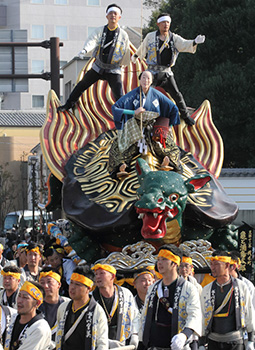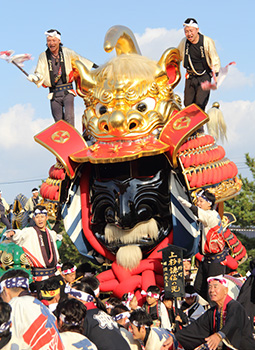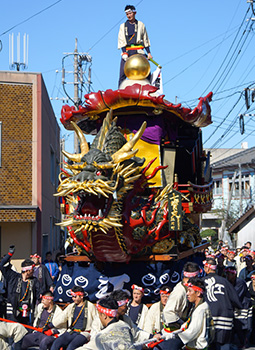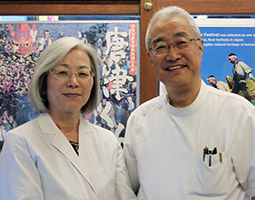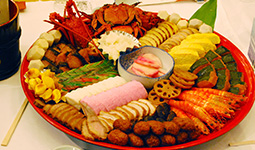Home > Highlighting JAPAN > Highlighting Japan November 2019 > Japan’s Food Culture
Highlighting JAPAN

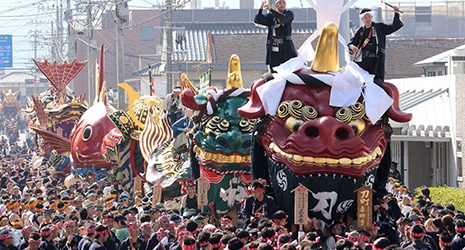
A Festive Feast for Family and Friends
In Karatsu City, Saga Prefecture, a festival is held in early November during which many people maintain an age-old family tradition of laying out a lavish feast.
In Karatsu City, Saga Prefecture, Karatsu Kunchi takes place on November 2–4 every year, attracting 500,000 visitors from Japan and overseas.
Karatsu Kunchi is the annual autumn festival of the Karatsu Shrine that commenced in the seventeenth century. The word “kunchi” in kanji means a day to “be grateful for the harvest and make offerings to the deity.” Fourteen magnificent floats more than 7 meters in height and weighing 2 to 3 tons in the shape of things such as shishi (lions), ryu (dragons) and tai (sea bream) parade through the city, pulled by a multitude of people. In 2016, Karatsu Kunchi was inscribed on UNESCO’s Representative List of the Intangible Cultural Heritage of Humanity as “Yama, Hoko, Yatai, float festivals in Japan” together with thirty-two other festive events.
In Karatsu City, the custom of serving a kunchi meal prepared on large dishes during the festival has been passed down from generation to generation in many families. People invite those who have continuously helped them, such as their business partners, relatives, friends and acquaintances, and entertain their guests with the meal.
At a kunchi meal, simmered ara (a large grouper) is one of the representative dishes, but the dishes are not necessarily clearly defined and vary from family to family.
“In my family, we prepare the meal for about 200 people every year, and preparations begin more than a month before the festival,” says Yoshitomi Hiroshi, who runs a pharmacy in the city.
The Yoshitomi family prepares ten to twelve different dishes, including kuri okowa (glutinous rice steamed with sweet chestnuts), chimaki (glutinous rice and other ingredients wrapped and steamed in bamboo leaves), zaru tofu (unwashed tofu prepared and served on a bamboo basket), and shirohanamame no satoni (candied white kidney beans).
Hiroshi’s wife, Yayoi, says, “In late September, we get the plates and utensils that we use for the kunchi meal from a warehouse in order to wash them. We also purchase and prepare the ingredients for the meal, such as the sweet chestnuts to be used for kuri okowa, during the month of September. If we didn’t make the arrangements early, we wouldn’t be able to get the necessary ingredients ready.”
In Karatsu, each town district also begins practicing the ohayashi, which is played with traditional Japanese instruments such as the fue (flute), kane (bell) and taiko (drum) at the time of the festival every night from October 1. The preparations made by people become increasingly frantic as the Karatsu Kunchi festival approaches. Around the eve of the festival on November 2, the final stage of the kunchi meal preparations begins, and a large number of dishes will be on the tables at noon on November 3.
When the festival begins, many people enjoy a kunchi meal by visiting the houses of their acquaintances around the city. It is also part of the fun of kunchi to have reunions with old friends and be introduced to new family members of relatives.
It costs a lot of money to prepare such lavish dishes and drinks. It is said that in the olden days, people in the city spent the equivalent of three months’ salary on preparing the kunchi meal.
“Even now, it costs a lot of money. People in Karatsu begin saving money in reserve deposits after Kunchi ends every year in preparation for the next year’s Kunchi,” says Hiroshi. “We still look forward to holding Kunchi every year. Many people, including our relatives who live far away and the schoolmates of our children, show up whenever we have Kunchi. It is our greatest pleasure to see our guests sitting around our lovingly prepared dishes and having fun. We hope to pass down this wonderful tradition, which is unique to Karatsu, indefinitely.”
© 2009 Cabinet Office, Government of Japan
